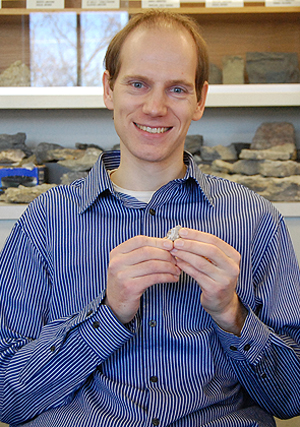KSU Graduate Found a “Thriller” of a discovery

Adiël Klompmaker discovered 100 million-year-old hermit crab fossils that he named after Michael Jackson. “This is not only a coincidence,” Klompmaker said. “It’s also good for the people studying these critters.” Photo by Nancy Urchak
February 15, 2012
Crab walk, meet the master of the moon walk: the King of Pop.
On June 25, 2009, Adiël Klompmaker, a Kent State professor in the Department of Geology and a Ph.D. candidate in paleontology, visited a limestone quarry in Spain with Dutch, Spanish and other American paleontologists. There, they found remains of 100-million-year-old crustacean decapods that included crabs, lobsters and shrimp.
Specifically, they found a 100-million-year-old fossil of a hermit crab the same day Michael Jackson passed away.
After the discovery, it took careful examination to confirm that what they had found was something new.
Mesoparapylocheles michaeljacksoni was the name chosen because,
“Later on that day, we saw on the TV in a local restaurant that Michael Jackson had passed away, unfortunately,” Klompmaker said. “Later on, we decided to honor the King of Pop by naming the hermit crab after him.”
The crab species named after Michael Jackson is part of a family of hermit crabs that was featured in a scientific paper, which happens rarely, he said.
“Michael Jackson was ‘the man’ in music when I was in elementary school, and I also remember the environmentally inspired song and video clip ‘Earth Song’ from his 1995 album ‘HIStory’.”
Klompmaker said finding this new fossil is important because it shows that there are a lot of things to be discovered.
The news was picked up here in the U.S. — The Huffington Post, Physorg.com, WJW FOX8 news — and also abroad — Great Britain, the Netherlands, China and Thailand — which Klompmaker said is good for the scientific community studying decapods.
Part of the fossil remains are in Klompmaker’s office and the other in the Netherlands. In the future, the fossils will be brought to the Museo Geológico del Seminario de Barcelona in Spain and the Dutch Oertijdmuseum, he said.
Along with his timeless music, “The Gloved One” will forever live on in scientific history.
Contact Maggie Thurston at [email protected].












